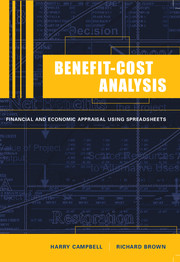Book contents
- Frontmatter
- Contents
- List of figures
- List of tables
- Preface
- Acknowledgements
- 1 Benefit-Cost Analysis: Introduction and Overview
- 2 Investment Appraisal: Principles
- 3 Investment Appraisal: Decision-Rules
- 4 Private Benefit-Cost Analysis: Financial Analysis
- 5 Efficiency Benefit-Cost Analysis
- 6 Calculating the Net Benefits to the Referent Group
- 7 Consumer and Producer Surplus in Benefit-Cost Analysis
- 8 Valuing Traded and Non-traded Commodities in Benefit-Cost Analysis
- 9 Incorporating Risk in Benefit-Cost Analysis
- 10 The Social Discount Rate, Cost of Public Funds, and the Value of Information
- 11 Weighting Net Benefits to Account for Income Distribution
- 12 Valuation of Non-marketed Goods
- 13 Economic Impact Analysis
- 14 Writing the Benefit-Cost Analysis Report
- Appendix 1 Case Study Assignment
- Appendix 2 Discount and Annuity Tables
- Index
Appendix 1 - Case Study Assignment
Published online by Cambridge University Press: 05 September 2012
- Frontmatter
- Contents
- List of figures
- List of tables
- Preface
- Acknowledgements
- 1 Benefit-Cost Analysis: Introduction and Overview
- 2 Investment Appraisal: Principles
- 3 Investment Appraisal: Decision-Rules
- 4 Private Benefit-Cost Analysis: Financial Analysis
- 5 Efficiency Benefit-Cost Analysis
- 6 Calculating the Net Benefits to the Referent Group
- 7 Consumer and Producer Surplus in Benefit-Cost Analysis
- 8 Valuing Traded and Non-traded Commodities in Benefit-Cost Analysis
- 9 Incorporating Risk in Benefit-Cost Analysis
- 10 The Social Discount Rate, Cost of Public Funds, and the Value of Information
- 11 Weighting Net Benefits to Account for Income Distribution
- 12 Valuation of Non-marketed Goods
- 13 Economic Impact Analysis
- 14 Writing the Benefit-Cost Analysis Report
- Appendix 1 Case Study Assignment
- Appendix 2 Discount and Annuity Tables
- Index
Summary
International Mining Corporation (IMC) Copper Mining Project
Project Description
The Government of Indonesia is considering a proposed joint venture with a foreign investor, International Mining Corporation (IMC), to develop a new copper mine in the mountainous and remote Eastern Province (EP) where recent geological surveys have revealed significant copper deposits. Under the proposal, Eastern Province Mining Limited (EPML), in which the Government of Indonesia (GOI) will hold 30% of the shares, will mine and mill the copper ore on site. The concentrate will then be transported (in slurry form) by pipeline to a dedicated port facility at the mouth of the Eastern Province River, from where it will be shipped to Japan for refining and sale on the world market. Although the main product is copper, the concentrate will also contain some quantities of gold and silver that will also be extracted from the concentrate at the refining stage and sold on the world market.
Eastern Province is a low-income region with a population of 5 million and a per capita income of around US$300 per annum, considered the least developed part of the country. The local population living in the area rely mainly on subsistence agriculture and fishing for their livelihoods. At present there is very little economic or social infrastructure in the area, which means that apart from on-site investment in the mine, mill and tailings dam, EPML will need to make substantial off-site investments in infrastructure and logistics, such as transport equipment, the construction of roads, bridges, wharfs, an airstrip, storage facilities, housing, power generation and supply, as well as the establishment of a school, hospital, shops, recreational facilities and other amenities for the locally engaged and expatriate employees and families.
- Type
- Chapter
- Information
- Benefit-Cost AnalysisFinancial and Economic Appraisal using Spreadsheets, pp. 332 - 339Publisher: Cambridge University PressPrint publication year: 2003



